Set against an enchanting harbor, Mokpo is one of Korea’s premier travel destinations, where stunning natural landscapes intertwine with a rich cultural heritage, giving the city an enduring charm.
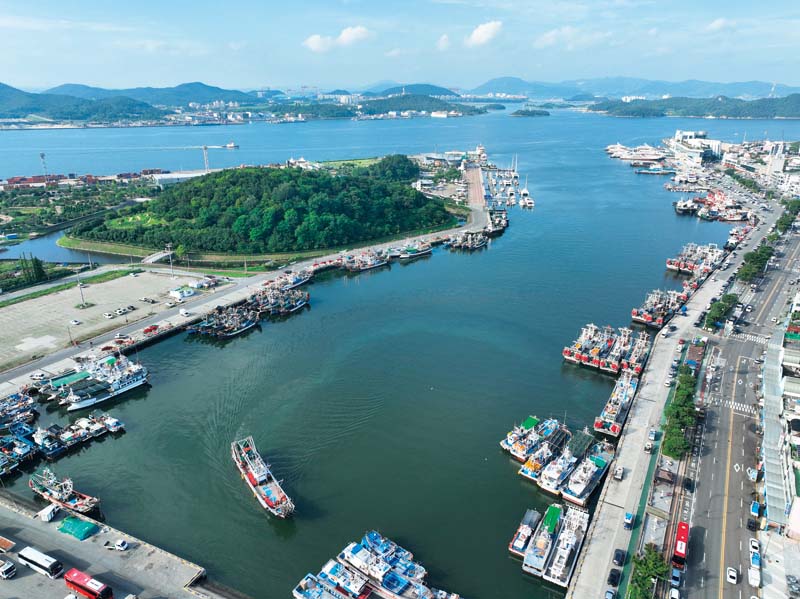
Positioned at the southwestern tip of the Korean peninsula and blessed with magnificent natural conditions, Mokpo Port serves as a regional economic engine and strategic gateway for Korea’s trade with China and Southeast Asia.
Nestled in the southwestern corner of the Korean peninsula, Mokpo sits with Mt. Yudal to the west and the mouth of the Yeongsan River to the south. A multitude of islands fringe the coast, creating a panorama of extraordinary beauty.
A good place to begin exploring the city is to observe it from above, aboard the Mokpo Marine Cable Car. Departing from the North Port Terminal, the cabins cross the iconic Mt. Yudal before rotating 68 degrees and traversing over Mokpo and the sea to reach Gohado. To reach this crescent-shaped island, the cabins pass over the world’s tallest concrete stanchion — a whopping 132 meters high — and travel 955 meters across the water on the world’s longest span between two towers on a single-cable track. Taking this aerial journey offers sweeping views and is like reading a contour map of the densely populated city of some 211,000 residents. The round trip takes around forty minutes, and daredevils can choose crystal cabins featuring transparent floors.
Gohado holds special historical significance for Koreans. It was here that Admiral Yi Sun-shin (1545–1598), one of the country’s greatest heroes, stationed himself before the famous Battle of Myeongnyang in 1597. Though vastly outnumbered, he defeated the Japanese fleet in the waters off Jindo. Following this triumph, he spent over a hundred days on Gohado, restoring his troops’ strength and morale. Retired as a naval command post, the island now serves as both a gateway to Mokpo Port and a natural breakwater.
Visitors can explore Gohado either by taking a leisurely stroll along the 1.8-kilometer elevated deck path tracing the coastline, or by wandering through the island’s dense groves of pine trees, many of which are over five hundred years old. The Gohado Observatory, resembling a stack of 13 of Yi Sun-shin’s battle ships, provides a panoramic view of Mokpo’s coast, the three-span cable-stayed Mokpo Bridge, and Mt. Yudal.
VIEWS FROM THE SUMMIT
Rising just 228 meters above sea level, Mt. Yudal is the centerpiece of Mokpo’s sightseeing attractions, accessible via several hiking trails or by taking the cable car to a point near the summit. A short stroll away is Yuseongak, the best-known of several observation decks. Built in 1932 in the style of a traditional pavilion to commemorate the 35th anniversary of Mokpo’s port opening, the observatory offers breathtaking views of not only Mokpo’s coastal waters but also the distant sea, dotted with islands from neighboring counties like Yeongam, Sinan, and Muan.
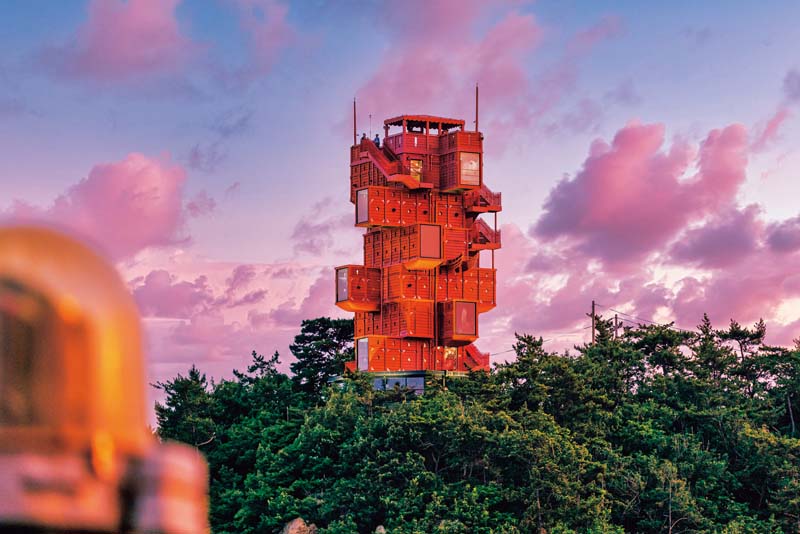
The Gohado Observatory honoring Korea’s greatest naval commander, Admiral Yi Sun-shin, consists of 13 replicas of panokseon, warships roofed with wooden planks, stacked on top of each other at different angles. The popular destination offers breathtaking views of Gohado, Mokpo’s coast, and Mt. Yudal.
© Mokpo City
Upon reaching Mt. Yudal’s summit, hikers can enjoy picture-perfect scenery of Mokpo no matter the time of day. During the daytime, the city spread below glows against the sky and sea. At sunset, it’s bathed in orange hues, and at night, it sparkles like the Milky Way, with twinkling lights dotting the darkness.
West of the mountain is Mokpo Skywalk, a romantic photography spot. This steel-and-glass structure, 120 meters long and 15 meters high, extends from the shoreline as both a walking path and observation deck. Two-thirds of the floor is made of tempered glass, offering clear views of the white sandy beach and ocean below. The thrilling sensation of walking on water has made the skywalk a must-visit attraction for tourists.
While the seascape around Mokpo Bridge and Gohado is always striking, the night view is particularly spectacular with the Skywalk, Mokpo Bridge, and the Marine Cable Car bathed in colorful lights. Since its completion in 2012, the bridge has become a major landmark, and for pedestrians, who aren’t allowed on the bridge itself, the Skywalk presents the best vantage point to admire it. The two triangles formed by the cables extending from the bridge’s main towers are designed to represent a crane, Mokpo’s symbolic bird, which is considered a good omen for longevity and luck.
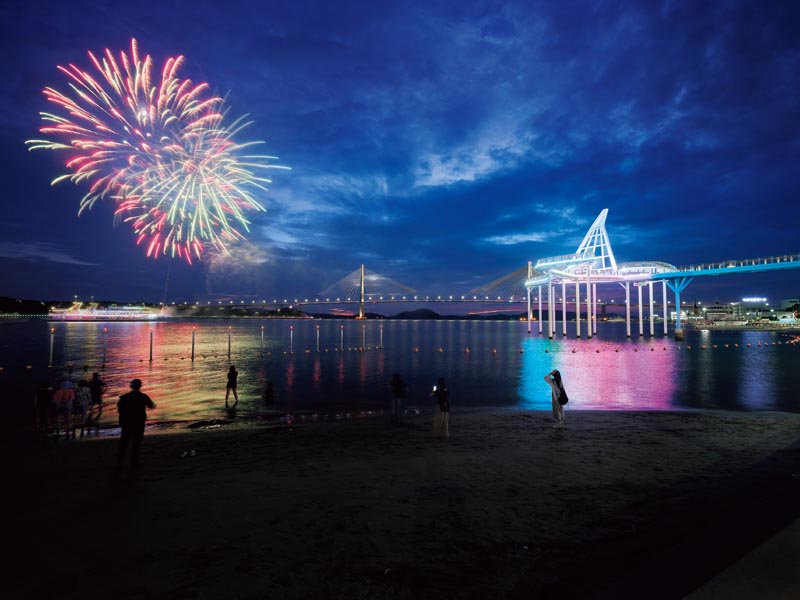
Opened in 1962, Yudal Beach has long been a favorite sandy retreat for both Mokpo residents and visitors. It is especially popular at night, when crowds gather on the Skywalk to admire the impressive Mokpo Bridge and the shimmering sea.
NOSTALGIC NEIGHBORHOOD
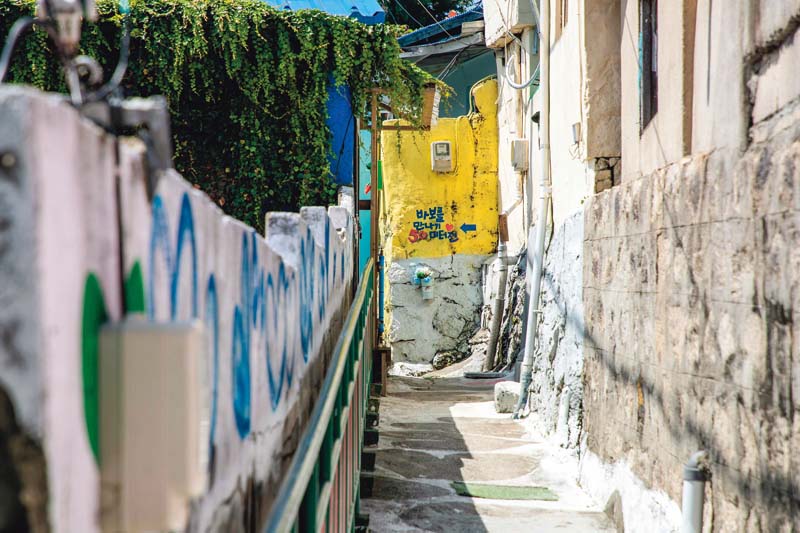
At the foot of Mt. Yudal, the Seosan-dong area forms a maze of narrow alleyways with houses clustered close together. Among these winding paths, the Poetry and Painting Alley particularly stands out for its nostalgic charm, which makes it a sought-after location for movies and TV series set in the 1980s.
© Korea Tourism Organization
About one kilometer south along the coast from the Skywalk, in the direction of Mokpo Port, signposts for the Poetry and Painting Alley (Sihwa Golmok) guide people to the narrow streets of Seosan-dong. Here the walls are adorned with poetry and artwork, giving the harborside neighborhood a distinctly Mokpo-esque character. Most of the men living here are fishermen and dockhands, whose single-story homes are densely packed on gentle slopes. The serenity of the village landscape and the daily life of its residents remain largely unchanged.
The Poetry and Painting Alley is the product of collaborative work by Mokpo’s poets, artists, and residents. Starting in 2015, they transformed what was once an ordinary harbor village into vibrant streets filled with colorful artwork and evocative poetry, animated by signs of everyday life such as flower pots or laundry fluttering in the breeze.
At the entrance to this area is Yeonhee’s Supermarket, preserved exactly as it was in the 1980s. It became a local landmark after featuring in the film 1987, which deals with Korea’s pro-democracy uprising in June that year. The film’s success drew visitors to Mokpo and turned the nostalgic neighborhood into a popular travel destination.
Just a ten-minute walk from Seosan-dong is Mokpo Port, where countless cargo ships and passenger ferries come and go, their horns echoing across the water. From here, passenger routes provide connections to nearby coastal islands — Yuldo, Dallido, and Oedaldo — as well as the islands of Sinan County farther off and even Jejudo. Oedaldo, a fifty-minute trip from the passenger terminal, has been attracting a growing number of travelers lately. The island features a small village surrounded by pristine natural scenery, with hanok accommodations for those seeking tranquil relaxation in a traditional home. There’s also a large seawater swimming pool, which is much sought after in summer.
Samhakdo, the island closest to Mokpo Port, can be reached on foot. Once altered due to land reclamation projects, it has been restored close to its original form in accordance with the wishes of citizens and transformed into a park with water leisure activities, such as kayaking and pedal boat rides. From its pier, sightseeing boats depart for tours of Mokpo’s coastal waters.
MOKPO ROCKS
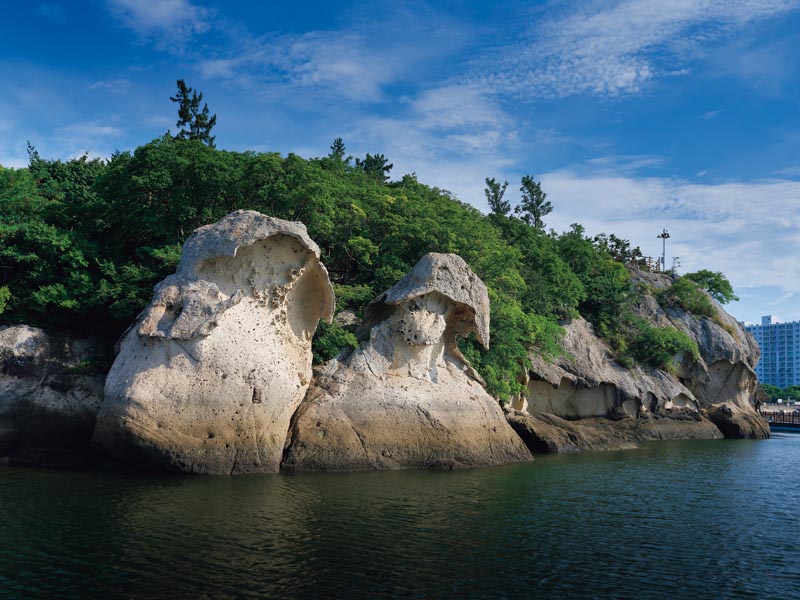
Gatbawi, a pair of rocks shrouded in legend and renowned for their distinctive shapes, rank among Mokpo’s top attractions. Thanks to the marine walkway installed along the Yeongsan River, visitors can now marvel at them while walking over the water.
Five kilometers east of Samhakdo by car, two eye-catching rocks known as Gatbawi rise from the coast. They resemble two people standing side by side wearing satgat — traditional conical hats woven from bamboo or reeds. According to legend, monks once rested on this spot and left behind their hats, which eventually turned into stone. These unusually shaped tuff rocks are a notable geological landmark, which have been designated a Natural Monument. Estimated to be eighty million years old, they were sculpted into their current shape by a combination of weathering and marine erosion.
Gatbawi was once only accessible by boat, but the opening of a floating pedestrian bridge in 2008 has made it much easier to see the rocks up close. The bridge rises about one meter during high tide, swaying gently with each step. The Gatbawi area is also Mokpo’s arts and culture hub with numerous exhibition spaces in the vicinity, including the National Research Institute of Maritime Cultural Heritage — Korea’s only maritime institution specializing in underwater archaeology. The museum houses over 20,000 artifacts and a large number of other objects from the Sinan shipwreck, a merchant vessel that sank near the Sinan islands in the 14th century and was explored and salvaged during several expeditions from 1976 to 1984.
When night falls in Mokpo, crowds flock to Peace Plaza to catch the Dancing Sea Fountain show, held at 8 p.m. April through November. Water jets leap and twirl to music, their movements set off by video projections and laser displays. For many visitors, views of the night sea beyond the plaza are an unforgettable highlight of a trip to Mokpo.